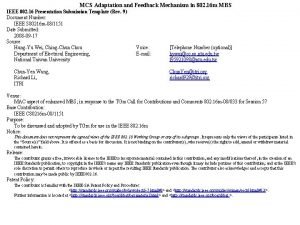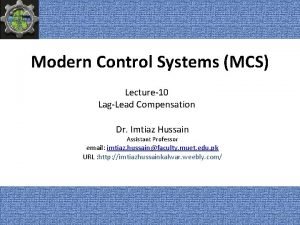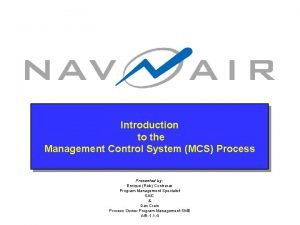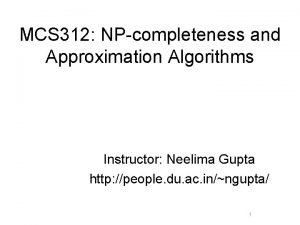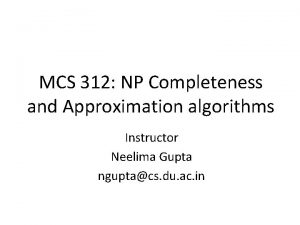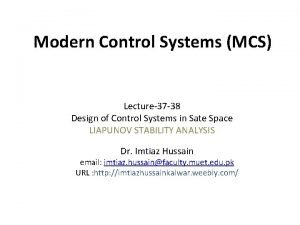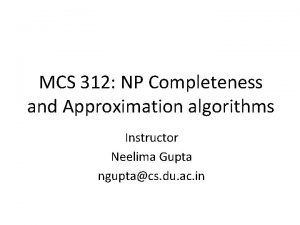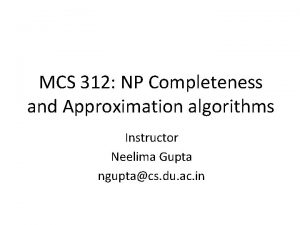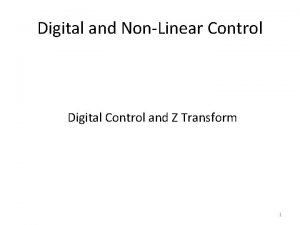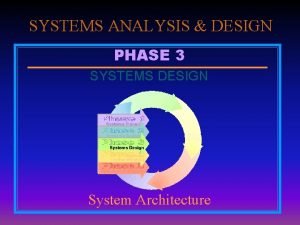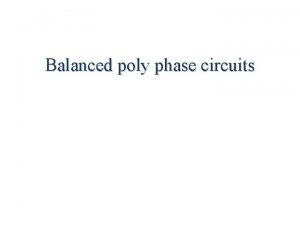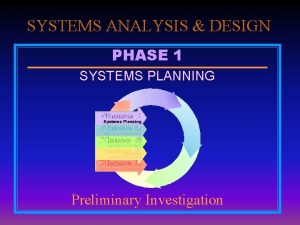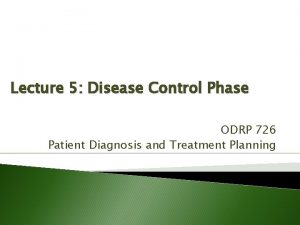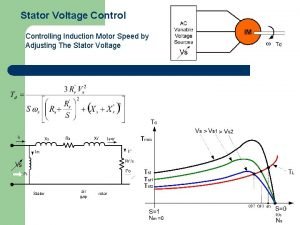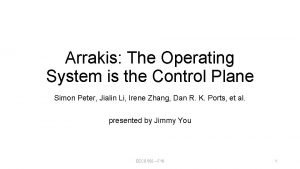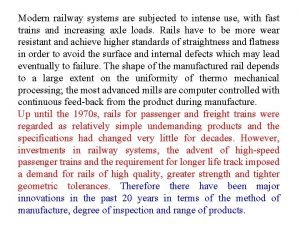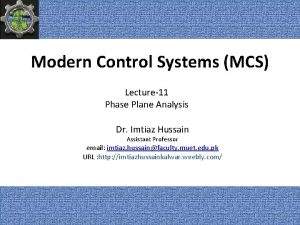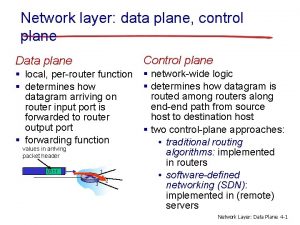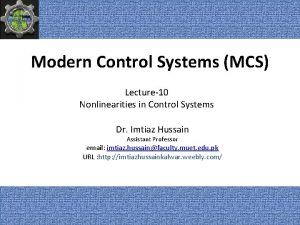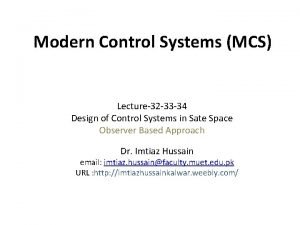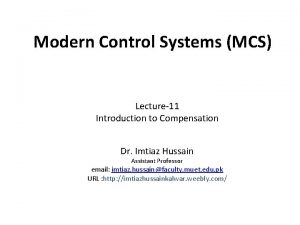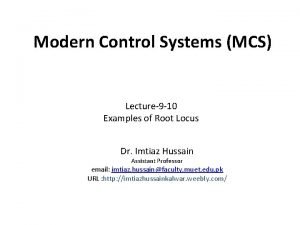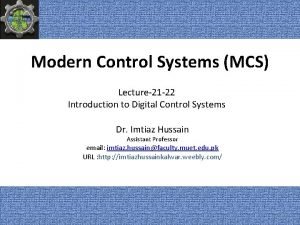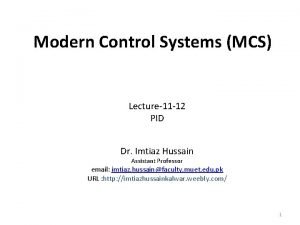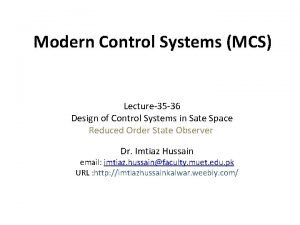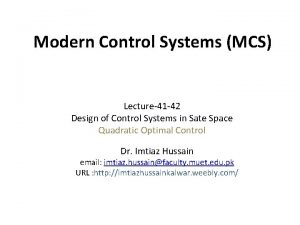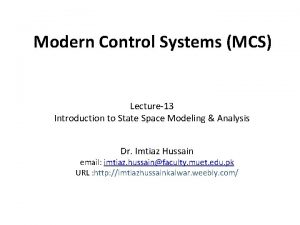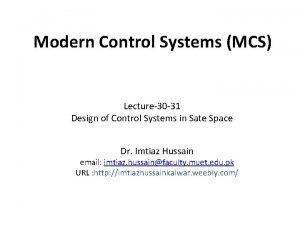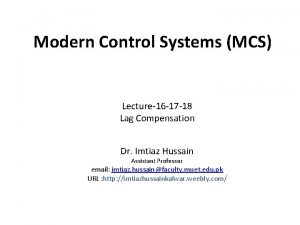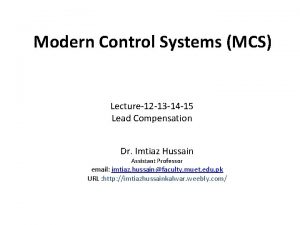Modern Control Systems MCS Lecture7 Phase Plane Analysis
















































- Slides: 48

Modern Control Systems (MCS) Lecture-7 Phase Plane Analysis Dr. Imtiaz Hussain Assistant Professor email: imtiaz. hussain@faculty. muet. edu. pk URL : http: //imtiazhussainkalwar. weebly. com/ 1

Introduction • The definition for stability for LTI systems is an easy concept to understand (eigenvalues). • It is necessary to extend the concept of stability to nonlinear systems. 2

Basic Idea • To generate motion trajectories corresponding to various initial conditions in the phase plane. • To examine the qualitative features of the trajectories. • In such a way, information concerning stability and other motion patterns of the system can be obtained. 3

State Space Trajectories • The unforced response of a system released from any initial point x(to) traces a curve or trajectory in state space, with time t as an implicit function along the trajectory. • When state variables are represented as phase variables, the state space is called phase space or phase plane. • The family of all trajectories (which started by different initial points) is called phase portrait. 4

Phase Plane Analysis • A graphical method: to visualize what goes on in a nonlinear system without solving the nonlinear equations analytically. • 2. Limitation: limited for second-order (or first –order) dynamic system; however, some practical control systems can be approximated as second-order systems. 5

How to Plot? • There a number of methods for constructing phase plane trajectories for linear or nonlinear system, such as 1. 2. 3. 4. 5. 6. 7. Solution of state equations analytical method The method of isoclines The delta method Lienard’s method Pell’s method Software Programs (based on above six methods) 6

Phase Plane Analysis of Linear Systems 7

- Consider the second-order linear system is the general solution • Where the eigenvalues and are the solutions of the characteristic equation 8

There is only one singular point (assuming ), namely the origin. 1. and are both real and have the same sign (positive or negative) 2. and are both real and have opposite signs (saddle point) 3. and real parts are complex conjugate with non-zero 4. and are complex conjugates with real parts equal to zero (center point) 9

10

11

12

13

14

Phase Portrait of LTI Systems • 15

Phase Portrait (Solution of state equations) • 16

Phase Portrait (Solution of state equations) t=0: 0. 01: 10; x 1=3*exp(-t)-3*exp(-3*t); x 2=-exp(-t)+3*exp(-3*t); plot(x 1, x 2) 17

Example-RLC Circuit • For the RLC circuit draw the state space trajectory with following initial conditions. Vc • Solution + + - - 18

Example-RLC Circuit • Following trajectory is obtained 19

Example-RLC Circuit 20

Equilibrium Point and Singular Points • Equilibrium point is defined as a point where the system states can stay forever • This implies that • 21

Equilibrium Point • The equilibrium or stationary state of the system is when 22

Examples of LTI systems • 23

Software Solution • x 1 dom = linspace(-5, 5, 51); x 2 dom = linspace(-5, 5, 51); [x 1, x 2] = meshgrid(xdom, ydom); % generate mesh of domain x 1 dot = x 1; % dx 1/dt X 2 dot= = -x 1 -4*x 2; % dx 2/dt quiver(x 1, x 2, x 1 dot, x 2 dot) % velocity Vectors 24

Enter Equations in PPlane Applet 25

Phase Plane Analysis of Nonlinear Systems 26

Introduction • In discussing the phase plane analysis of nonlinear systems, two points should be kept in mind: – Phase plane analysis of nonlinear systems is related to that of liner systems, because the local behavior of nonlinear systems can be approximated by the behavior of a linear system. – Nonlinear systems can display much more complicated patterns in the phase plane, such as multiple equilibrium points and limit cycles. 27

Example

Equilibrium States

Example: Simple Pendulum • Consider the pendulum shown in figure. Where, L: the pendulum’s length M: its mass b: the friction coefficient at the hinge g: the gravity constant.

Example: Simple Pendulum • State equation of the system are given as

• The equilibrium points: x 2 = 0, sin x 1 = 0 (0, 0) and (π, 0) • The pendulum resting exactly at the vertical up and down positions.

Example • Consider a nonlinear system described by following state equations determine the number of equilibrium point(s) of the system. Answer (1, 1) and (− 1, − 1). 33

Example • Consider a nonlinear system described by following state equations determine the number of equilibrium point(s) of the system. Answer (0, 0) and (− 1/2, 1). 34

Local Behavior of Nonlinear Systems • If the singular point of interest is not at the origin, by defining the difference between the original state and the singular point as a new set of state variables, we can shift the singular point to the origin. • Using Taylor expansion a second order nonlinear system can be rewritten in the form 35

Local Behavior of Nonlinear Systems • In the vicinity of the origin, the higher order terms can be neglected, and therefore, the nonlinear system trajectories essentially satisfy the linearized equation • As a result, the local behavior of the nonlinear system can be approximated by the patterns shown by linear systems 36

Limit Cycle • In the phase plane, a limit cycle is defied as an isolated closed curve. • The trajectory has to be both closed, indicating the periodic nature of the motion, and isolated, indicating the limiting nature of the cycle (with near by trajectories converging or diverging from it). 37

Limit Cycle • Depending on the motion patterns of the trajectories in the vicinity of the limit cycle, we can distinguish three kinds of limit cycles. – Stable Limit Cycles: all trajectories in the vicinity of the limit cycle converge to it as t →∞ – Unstable Limit Cycles: all trajectories in the vicinity of the limit cycle diverge to it as t →∞ 38

Limit Cycle – Semi-Stable Limit Cycles: some of the trajectories in the vicinity of the limit cycle converge to it as t →∞ 39

Example • Find the equilibrium point(s) of the nonlinear system. Then determine the type and stability of each equilibrium point. • If system exhibits limit cycles then determine the nature of limit cycle as well. 40

Example • Find the equilibrium point(s) of each nonlinear system given below. Then determine the type and stability of each equilibrium point. 1). 2). • If system exhibits limit cycles then determine the nature of limit cycle as well. 41

Exercise • Find the equilibrium point(s) of each nonlinear system given below. Then determine the type and stability of each equilibrium point. If system exhibits limit cycles then determine the nature of limit cycle as well. 1). 2). 4). 5). 3). 42

Solution 1). • Equilibrium points are (0, 0) and (− 3, 3). • (0, 0) is a stable center, • (− 3, 3) is an unstable saddle point. 43

Solution 2). • Equilibrium points are (0, 1) and (1/4, 3/4) • (0, 1) is an unstable saddle point, • (1/4, 3/4) is an unstable spiral point. 44

Solution 3). • • • Equilibrium points are (2, 3), (2, − 3), (3, 2) and (− 3, 2). (2, 3) is an unstable saddle point (2, − 3) is an unstable saddle point (3, 2) is an unstable node, (− 3, 2) is an asymptotically stable node. 45

Solution 4). • • Equilibrium points are (1, 1), (1, − 1), (− 1, 1), and (− 1, − 1). (1, 1) is an asymptotically stable spiral point, (1, − 1) and (− 1, 1) both are unstable saddle points, (− 1, − 1) is an unstable spiral point. 46

Solution 5). • • Equilibrium points are (0, 0), (2, 4), and (− 5, 4). (0, 0) is an unstable saddle point, (2, 4) is an unstable node, (− 5, 4) is an asymptotically stable node. 47

To download this lecture visit http: //imtiazhussainkalwar. weebly. com/ END OF LECTURE-7 48
 Data plane control plane and management plane
Data plane control plane and management plane Mpls control plane and data plane
Mpls control plane and data plane Modern systems analysis and design
Modern systems analysis and design Modern system analysis and design
Modern system analysis and design A modern approach to systems analysis and design
A modern approach to systems analysis and design Modern systems analysis and design 7th edition
Modern systems analysis and design 7th edition Mcs chiller controls
Mcs chiller controls Vad är mcs
Vad är mcs Mcs feedback
Mcs feedback Cisco titration
Cisco titration Mcs motivo causa solução
Mcs motivo causa solução Mcscontrols
Mcscontrols Double red cell
Double red cell Jpams mcs
Jpams mcs Mcs weebly
Mcs weebly Linkit 7697 wifi
Linkit 7697 wifi Mcs process
Mcs process Katherine hubler
Katherine hubler Mcs 312
Mcs 312 Mcs 312
Mcs 312 Mcs weebly
Mcs weebly Mcs magnum controller
Mcs magnum controller Mcs 312
Mcs 312 Mcs 312
Mcs 312 Normal phase vs reverse phase chromatography
Normal phase vs reverse phase chromatography M tswett pronunciation
M tswett pronunciation Mobile phase and stationary phase
Mobile phase and stationary phase Chromatography mobile phase and stationary phase
Chromatography mobile phase and stationary phase Normal phase vs reverse phase chromatography
Normal phase vs reverse phase chromatography Phase to phase voltage
Phase to phase voltage Detectors used in hplc
Detectors used in hplc In a triangle connected source feeding a y connected load
In a triangle connected source feeding a y connected load Broad phase vs narrow phase
Broad phase vs narrow phase Mapping between s plane and z plane
Mapping between s plane and z plane Plane stress plane strain
Plane stress plane strain This is the final task in phase 3: systems design
This is the final task in phase 3: systems design Output of design phase
Output of design phase Four phase power
Four phase power This is the final task in phase 3: systems design.
This is the final task in phase 3: systems design. This is the final task in phase 3 systems design
This is the final task in phase 3 systems design Disease control phase dental
Disease control phase dental Thyristor application
Thyristor application Cpi training coping model
Cpi training coping model Stator voltage control of induction motor
Stator voltage control of induction motor Arrakis os
Arrakis os Modern railway systems
Modern railway systems What is modern operating system
What is modern operating system Modern recovery systems
Modern recovery systems Virtualization technology in modern operating systems
Virtualization technology in modern operating systems








